Abstract
We have constructed and cloned in bacteria recombinant plasmids containing DNA complementary to the mRNA encoding a pancreatic preproglucagon (Mr 14,500), a product of cell-free translation of angler fish islet mRNAs shown previously by immunoprecipitation analyses to be a precursor of glucagon. cDNAs of 630, 180, and 120 base pairs were isolated and correspond to most of the mRNA for the preproglucagon (650 bases). The cDNAs contain a protein coding sequence of 372 nucleotides and 5'- and 3'-untranslated regions of 58 and 206 nucleotides, respectively. From the coding sequence of the cDNAs, we find that the sequence of glucagon, identical to mammalian glucagon in 20 of 29 positions, resides in the preproglucagon of 124 amino acids flanked by NH2- and COOH-peptide extensions of 52 and 43 amino acids, respectively. The peptide extensions are linked to the glucagon by Lys-Arg sequences characteristic of the sites that are cleaved during the posttranslational processing of prohormones. Notable is the finding that, following the initial Lys-Arg sequence in the COOH-peptide extension is a pentapeptide. Ser-Gly-Val-Ala-Glu, followed by another Lys-Arg and a sequence of 34 residues that shows striking homology with glucagon and the other peptides of the glucagon family--gastric inhibitory peptide, vasoactive intestinal peptide, and secretin. Thus, the preproglucagon mRNA contains two glucagon-related coding sequences arranged in tandem. The finding of Lys-Arg sequences flanking the glucagon and glucagon-related sequences suggests that these two peptides and a pentapeptide are formed in vivo by posttranslational cleavages of a common precursor.
Full text
PDF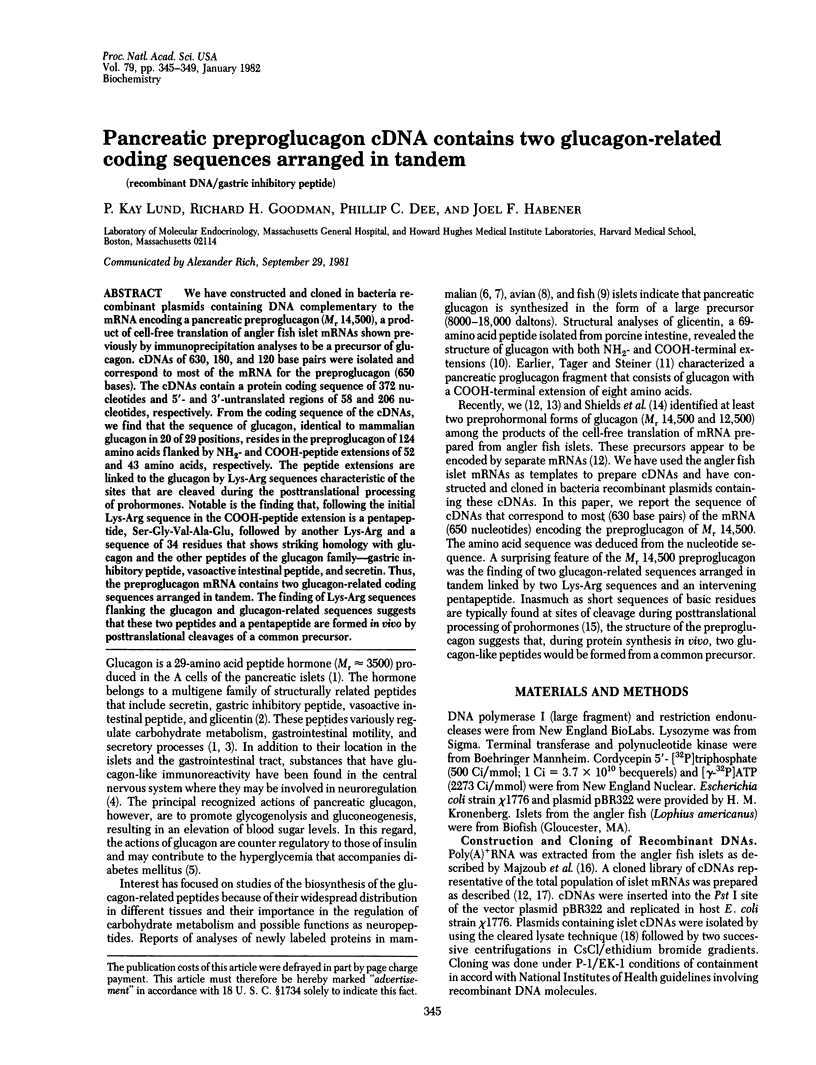
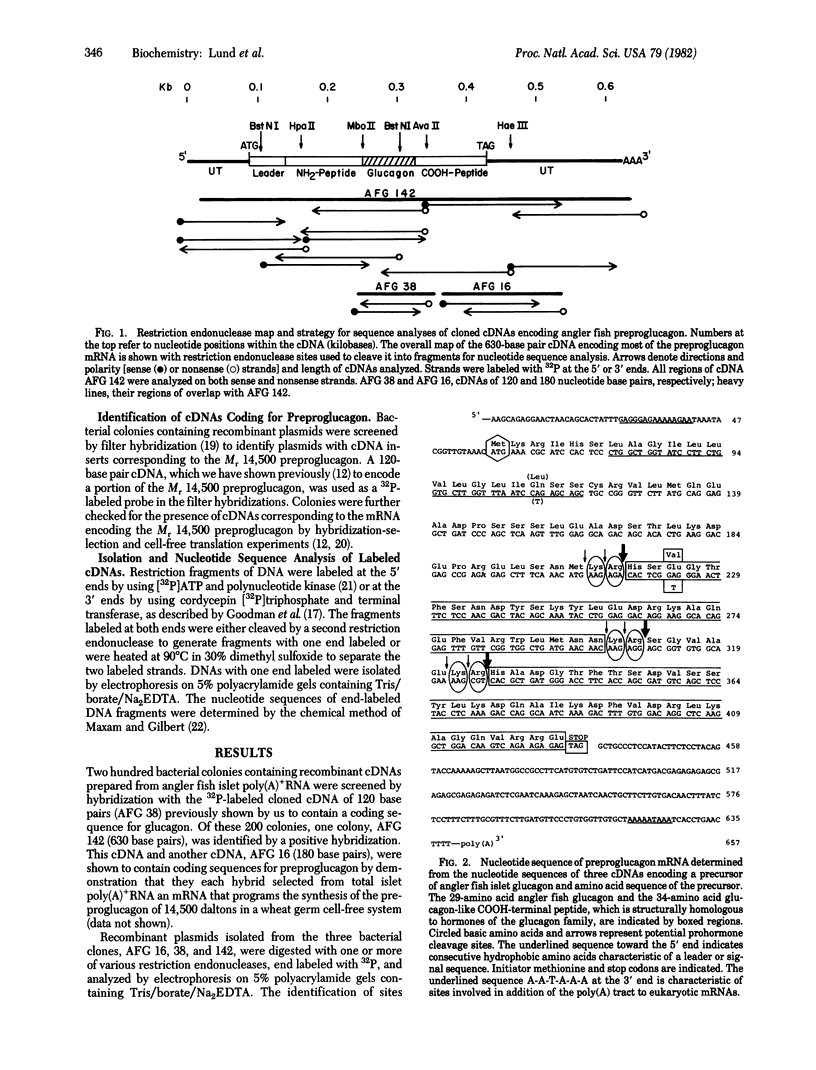
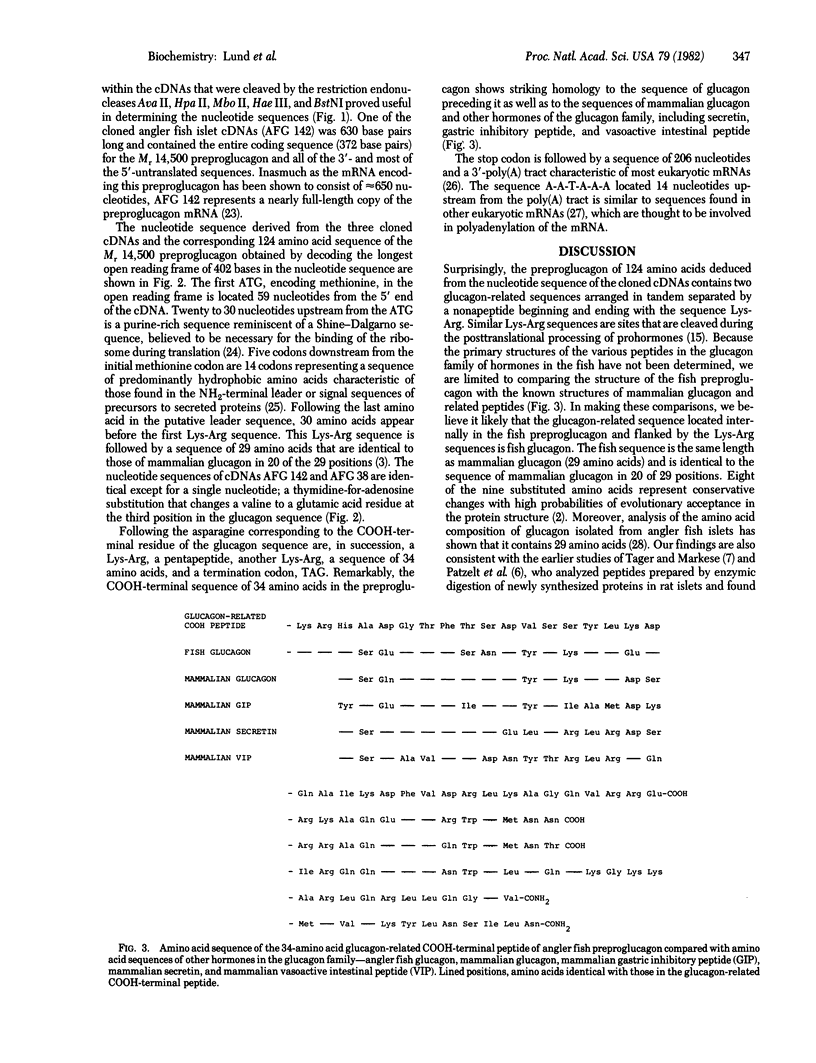
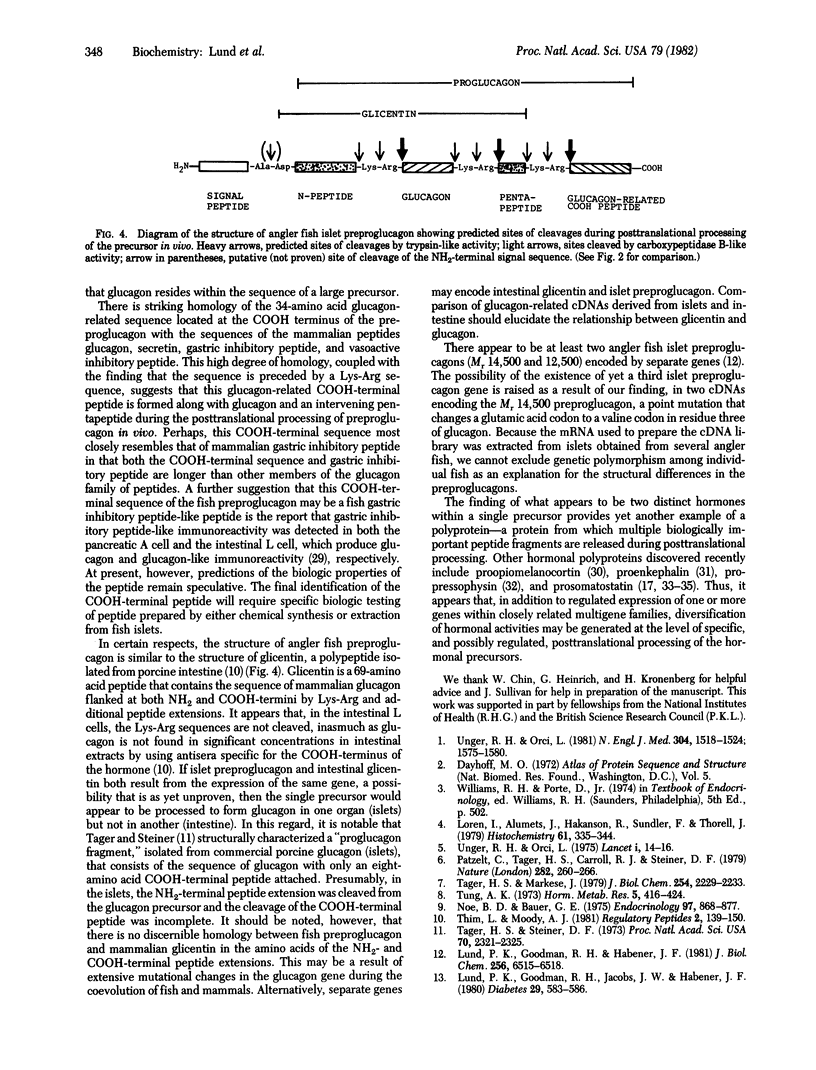
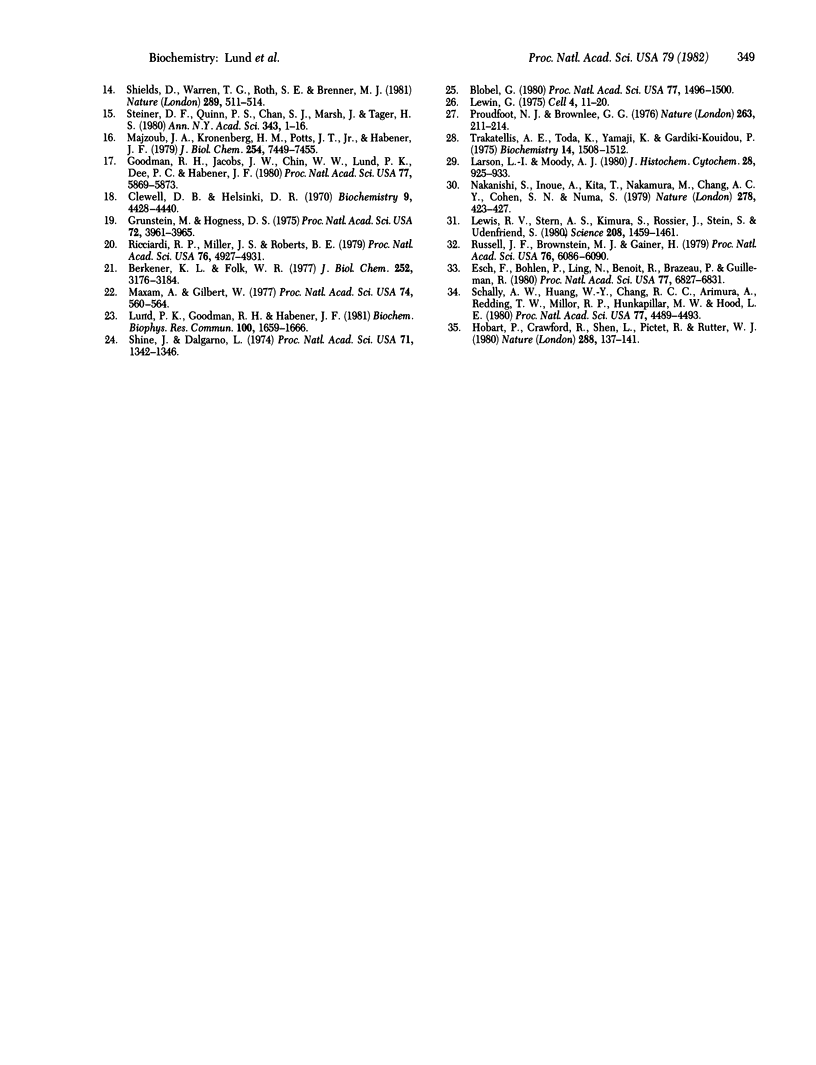
Selected References
These references are in PubMed. This may not be the complete list of references from this article.
- Berkner K. L., Folk W. R. Polynucleotide kinase exchange reaction: quantitave assay for restriction endonuclease-generated 5'-phosphoroyl termini in DNA. J Biol Chem. 1977 May 25;252(10):3176–3184. [PubMed] [Google Scholar]
- Blobel G. Intracellular protein topogenesis. Proc Natl Acad Sci U S A. 1980 Mar;77(3):1496–1500. doi: 10.1073/pnas.77.3.1496. [DOI] [PMC free article] [PubMed] [Google Scholar]
- Clewell D. B., Helinski D. R. Properties of a supercoiled deoxyribonucleic acid-protein relaxation complex and strand specificity of the relaxation event. Biochemistry. 1970 Oct 27;9(22):4428–4440. doi: 10.1021/bi00824a026. [DOI] [PubMed] [Google Scholar]
- Esch F., Böhlen P., Ling N., Benoit R., Brazeau P., Guillemin R. Primary structure of ovine hypothalamic somatostatin-28 and somatostatin-25. Proc Natl Acad Sci U S A. 1980 Nov;77(11):6827–6831. doi: 10.1073/pnas.77.11.6827. [DOI] [PMC free article] [PubMed] [Google Scholar]
- Goodman R. H., Jacobs J. W., Chin W. W., Lund P. K., Dee P. C., Habener J. F. Nucleotide sequence of a cloned structural gene coding for a precursor of pancreatic somatostatin. Proc Natl Acad Sci U S A. 1980 Oct;77(10):5869–5873. doi: 10.1073/pnas.77.10.5869. [DOI] [PMC free article] [PubMed] [Google Scholar]
- Grunstein M., Hogness D. S. Colony hybridization: a method for the isolation of cloned DNAs that contain a specific gene. Proc Natl Acad Sci U S A. 1975 Oct;72(10):3961–3965. doi: 10.1073/pnas.72.10.3961. [DOI] [PMC free article] [PubMed] [Google Scholar]
- Hobart P., Crawford R., Shen L., Pictet R., Rutter W. J. Cloning and sequence analysis of cDNAs encoding two distinct somatostatin precursors found in the endocrine pancreas of anglerfish. Nature. 1980 Nov 13;288(5787):137–141. doi: 10.1038/288137a0. [DOI] [PubMed] [Google Scholar]
- Larsson L. I., Moody A. J. Glicentin and gastric inhibitory polypeptide immunoreactivity in endocrine cells of the gut and pancreas. J Histochem Cytochem. 1980 Sep;28(9):925–933. doi: 10.1177/28.9.6997368. [DOI] [PubMed] [Google Scholar]
- Lewin B. Units of transcription and translation: the relationship between heterogeneous nuclear RNA and messenger RNA. Cell. 1975 Jan;4(1):11–20. doi: 10.1016/0092-8674(75)90128-2. [DOI] [PubMed] [Google Scholar]
- Lewis R. V., Stern A. S., Kimura S., Rossier J., Stein S., Udenfriend S. An about 50,000-dalton protein in adrenal medulla: a common precursor of [Met]- and [Leu]enkephalin. Science. 1980 Jun 27;208(4451):1459–1461. doi: 10.1126/science.7384787. [DOI] [PubMed] [Google Scholar]
- Lorén I., Alumets J., Håkanson R., Sundler F., Thorell J. Gut-type glucagon immunoreactivity in nerves of the rat brain. Histochemistry. 1979 Jul 11;61(3):335–341. doi: 10.1007/BF00508455. [DOI] [PubMed] [Google Scholar]
- Lund P. K., Goodman R. H., Habener J. F. Intestinal glucagon mRNA identified by hybridization to a cloned islet cDNA encoding a precursor. Biochem Biophys Res Commun. 1981 Jun;100(4):1659–1666. doi: 10.1016/0006-291x(81)90709-9. [DOI] [PubMed] [Google Scholar]
- Lund P. K., Goodman R. H., Habener J. F. Pancreatic pre-proglucagons are encoded by two separate mRNAs. J Biol Chem. 1981 Jul 10;256(13):6515–6518. [PubMed] [Google Scholar]
- Lund P. K., Goodman R. H., Jacobs J. W., Habener J. F. Glucagon precursors identified by immunoprecipitation of products of cell-free translation of messenger RNA. Diabetes. 1980 Jul;29(7):583–586. doi: 10.2337/diab.29.7.583. [DOI] [PubMed] [Google Scholar]
- Majzoub J. A., Kronenberg H. M., Potts J. T., Jr, Rich A., Habener J. F. Identification and cell-free translation of mRNA coding for a precursor of parathyroid secretory protein. J Biol Chem. 1979 Aug 10;254(15):7449–7455. [PubMed] [Google Scholar]
- Maxam A. M., Gilbert W. A new method for sequencing DNA. Proc Natl Acad Sci U S A. 1977 Feb;74(2):560–564. doi: 10.1073/pnas.74.2.560. [DOI] [PMC free article] [PubMed] [Google Scholar]
- Nakanishi S., Inoue A., Kita T., Nakamura M., Chang A. C., Cohen S. N., Numa S. Nucleotide sequence of cloned cDNA for bovine corticotropin-beta-lipotropin precursor. Nature. 1979 Mar 29;278(5703):423–427. doi: 10.1038/278423a0. [DOI] [PubMed] [Google Scholar]
- Noe B. D., Bauer G. E. Evidence of sequential metabolic cleavage of proglucagon to glucagon in glucagon biosynthesis. Endocrinology. 1975 Oct;97(4):868–877. doi: 10.1210/endo-97-4-868. [DOI] [PubMed] [Google Scholar]
- Patzelt C., Tager H. S., Carroll R. J., Steiner D. F. Identification and processing of proglucagon in pancreatic islets. Nature. 1979 Nov 15;282(5736):260–266. doi: 10.1038/282260a0. [DOI] [PubMed] [Google Scholar]
- Proudfoot N. J., Brownlee G. G. 3' non-coding region sequences in eukaryotic messenger RNA. Nature. 1976 Sep 16;263(5574):211–214. doi: 10.1038/263211a0. [DOI] [PubMed] [Google Scholar]
- Ricciardi R. P., Miller J. S., Roberts B. E. Purification and mapping of specific mRNAs by hybridization-selection and cell-free translation. Proc Natl Acad Sci U S A. 1979 Oct;76(10):4927–4931. doi: 10.1073/pnas.76.10.4927. [DOI] [PMC free article] [PubMed] [Google Scholar]
- Russell J. T., Brownstein M. J., Gainer H. Trypsin liberates an arginine vasopressin-like peptide and neurophysin from a Mr 20,000 putative common precursor. Proc Natl Acad Sci U S A. 1979 Dec;76(12):6086–6090. doi: 10.1073/pnas.76.12.6086. [DOI] [PMC free article] [PubMed] [Google Scholar]
- Schally A. V., Huang W. Y., Chang R. C., Arimura A., Redding T. W., Millar R. P., Hunkapiller M. W., Hood L. E. Isolation and structure of pro-somatostatin: a putative somatostatin precursor from pig hypothalamus. Proc Natl Acad Sci U S A. 1980 Aug;77(8):4489–4493. doi: 10.1073/pnas.77.8.4489. [DOI] [PMC free article] [PubMed] [Google Scholar]
- Shields D., Warren T. G., Roth S. E., Brenner M. J. Cell-free synthesis and processing of multiple precursors to glucagon. Nature. 1981 Feb 5;289(5797):511–514. doi: 10.1038/289511a0. [DOI] [PubMed] [Google Scholar]
- Shine J., Dalgarno L. The 3'-terminal sequence of Escherichia coli 16S ribosomal RNA: complementarity to nonsense triplets and ribosome binding sites. Proc Natl Acad Sci U S A. 1974 Apr;71(4):1342–1346. doi: 10.1073/pnas.71.4.1342. [DOI] [PMC free article] [PubMed] [Google Scholar]
- Steiner D. F., Quinn P. S., Chan S. J., Marsh J., Tager H. S. Processing mechanisms in the biosynthesis of proteins. Ann N Y Acad Sci. 1980;343:1–16. doi: 10.1111/j.1749-6632.1980.tb47238.x. [DOI] [PubMed] [Google Scholar]
- Tager H. S., Markese J. Intestinal and pancreatic glucagon-like peptides. Evidence for identity of higher molecular weight forms. J Biol Chem. 1979 Apr 10;254(7):2229–2233. [PubMed] [Google Scholar]
- Tager H. S., Steiner D. F. Isolation of a glucagon-containing peptide: primary structure of a possible fragment of proglucagon. Proc Natl Acad Sci U S A. 1973 Aug;70(8):2321–2325. doi: 10.1073/pnas.70.8.2321. [DOI] [PMC free article] [PubMed] [Google Scholar]
- Thim L., Moody A. J. The primary structure of porcine glicentin (proglucagon). Regul Pept. 1981 May;2(2):139–150. doi: 10.1016/0167-0115(81)90007-0. [DOI] [PubMed] [Google Scholar]
- Trakatellis A. C., Tada K., Yamaji K., Gardiki-Kouidou P. Isolation and partial characterization of anglefish proglucagon. Biochemistry. 1975 Apr 8;14(7):1508–1512. doi: 10.1021/bi00678a025. [DOI] [PubMed] [Google Scholar]
- Tung A. K. Biosynthesis of avian glucagon: evidence for a possible high molecular weight biosynthetic intermediate. Horm Metab Res. 1973 Nov;5(6):416–424. doi: 10.1055/s-0028-1093915. [DOI] [PubMed] [Google Scholar]
- Unger R. H., Orci L. Glucagon and the A cell: physiology and pathophysiology (first two parts). N Engl J Med. 1981 Jun 18;304(25):1518–1524. doi: 10.1056/NEJM198106183042504. [DOI] [PubMed] [Google Scholar]
- Unger R. H., Orci L. The essential role of glucagon in the pathogenesis of diabetes mellitus. Lancet. 1975 Jan 4;1(7897):14–16. doi: 10.1016/s0140-6736(75)92375-2. [DOI] [PubMed] [Google Scholar]


